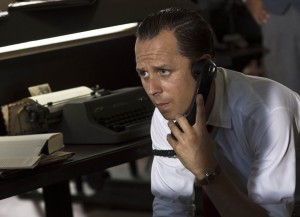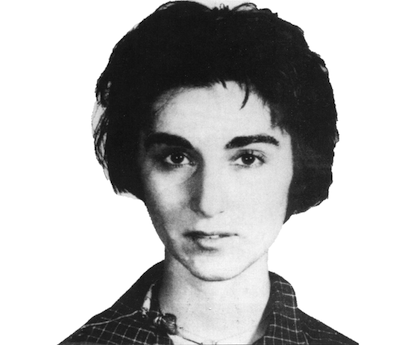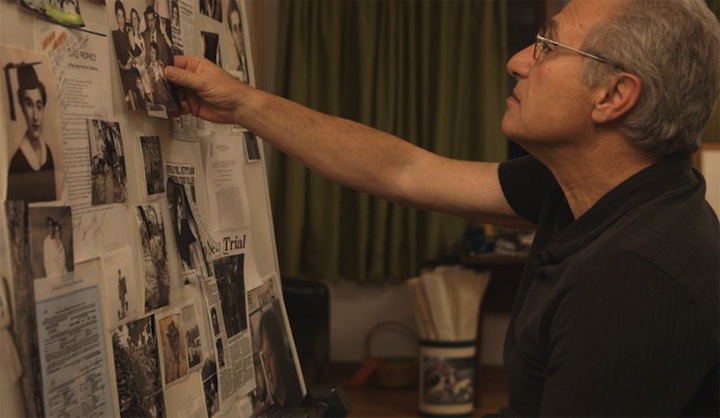by Melanie Crew
Managing Editor
PAPA: HEMINGWAY IN CUBA (2015); Dir. Bob Yari; Starring Giovanni Ribisi, Adrian Sparks, Joely Richardson; Opens Friday, April 29 at select Atlanta theatres (theatre list here); Trailer here.
Bob Yari’s [MIND GAMES (1989)/dir.; CRASH (2004)/producer; THE ILLUSIONIST (2006)/producer] PAPA: HEMINGWAY IN CUBA, after two years in the making, finally releases to the masses, April 29, in select theatres across the country. PAPA delivers a poignant punch to the gut, while giving the audience a bitter glimpse into Cuba’s bloody history. Yari’s film tells the true tale of a boy (Denne Petitclerc “Ed Myers”/Giovanni Ribisi) abandoned by his own family as a child in the mid-1930s. The boy later is invited to Havana and taken in as a mentee by the larger than life, Ernest Hemingway (Adrian Sparks) in the midst of Fidel Castro’s armed revolt. As the first Hollywood film shot in Cuba in half a century, PAPA reveals not only the inner workings of a country mid-revolution in the late 1950s, but also exposes a side of Hemingway rarely depicted. To top it all off, Yari’s use of Petitclerc’s actual story locations, including Hemingway’s home, gives the audience a closer glimpse into the ghosts of Petitclerc’s and Hemingway’s past.

Giovanni Ribisi as Ed Myers
Yari steps away from the stereotypical brightly colored flamboyancy and rambunctious nightlife that is usually attributed to Cuba and even sometimes Hemingway. His settings and shots reveal the softer side of both, shrouding them in pale-colored linen and visually pleasing muted lighting, up close and personal. Don’t get me wrong. The Hemingway we have grown to love and/or hate is in full swing; cursing, drinking and sexually overt. But we also see a man torn apart by his past, nauseated by his personal celebrity and longing for a connection to his younger self and the love he left behind; a writer of words first; a man second. And he finds this connection in Ed Myers.
Ribisi, usually cast in unstable and somewhat chaotic roles, splendidly pulls off Ed Myers’ slightly naïve, yet driven character. Always wanting to be a writer, but not quite skilled. Myers clings tightly to Hemingway’s written word and creates for himself an imaginary father figure who gives him the courage to fulfill this calling. Myers goes on to become a Korean War correspondent and then a journalist for The Miami Herald, where we are first introduced to the character. Myers attributes Hemingway’s writing to his own budding success and decides on a whim to write a poignant letter to his mentor thanking him for the part he unknowingly played in his life. And of course, Myers expected nothing in return. Boy did Myers get more than he bargained for. Yari’s pairing of Ribisi and Sparks, the almost frail Myers and the overtly thunderous Hemingway, made for onscreen chemistry rarely matched.

Adrian Sparks, Joely Richardson, Giovanni Ribisi
Sparks had some pretty big shoes to fill, portraying the larger than life Hemingway. Sparks’ ability to pull off Papa’s typical mountainous machismo while ever so slightly exposing a vulnerability rarely seen, was heartbreaking and felt more realistic than not. Sparks’ onscreen chemistry with Joely Richardson (Mary Hemingway, fourth wife and widow of Papa) was spot-on, even when things got ugly. Sparks flawlessly portrayed the repulsive portions of Hemingway, while effortlessly pulling the heartstrings of the audience throughout. Richardson, packed a punch in her own right as Mary, going toe to toe with the man she loved, despite his shortcomings. Not only does Yari’s film give us an insider’s glimpse into the real Papa, but it outlines his struggles with the past, his demons within and the battles he fought with the American government (i.e. J. Edgar Hoover and his hounds) that eventually led to his leaving Cuba, and taking his own life.
PAPA: HEMINGWAY IN CUBA is a film well worth checking out, particularly for those who desire a rarely depicted view of Hemingway. Ribisi’s and Sparks’ portrayal of characters that couldn’t be more opposite while being so similar is outstanding. PAPA is a rare exploration of a man who was loved and hated equally by the critics and the  American public, set in a location equally loved and despised. Yari’s film explores the not so pretty past of the man and the country, while painting a picture of love, respect and the need for connection. In retrospect, Papa is Cuba. Yari’s film is a beautifully crafted piece of cinema, featuring standout performances, shrouded in linen and set in paradise. It’s one you won’t want to miss!
American public, set in a location equally loved and despised. Yari’s film explores the not so pretty past of the man and the country, while painting a picture of love, respect and the need for connection. In retrospect, Papa is Cuba. Yari’s film is a beautifully crafted piece of cinema, featuring standout performances, shrouded in linen and set in paradise. It’s one you won’t want to miss!

 SIREN (2016); Dir. Gregg Bishop; Starring Hannah Fierman, Chase Williamson; Justin Welborn; IMDB link
SIREN (2016); Dir. Gregg Bishop; Starring Hannah Fierman, Chase Williamson; Justin Welborn; IMDB link 





 The center of the film, however, remains Bill Genovese, who narrates and drives the action as he pieces together the truth, which is not so simple a thing as the ‘facts.’ He doesn’t only want to know what happened, but why, and even how. Confined to a wheelchair due to his war injuries, Genovese is a nonetheless imposing figure as he confronts reporters, lawyers, and even the aging witnesses in an attempt to set the record straight in his mind. (He has a journalist’s tenacity, often asking witnesses if they ever spoke to the police, and then regardless of their answer, revealing that he has their police statement right in front of him.) He is the witness of the film’s title, not present at the event itself, but willing to stand for his sister, to shine light on her vibrant and rich existence (and, in a particularly moving section of the film, her secrets) to reclaim her from the cold register of history and return her, in some way, to life.
The center of the film, however, remains Bill Genovese, who narrates and drives the action as he pieces together the truth, which is not so simple a thing as the ‘facts.’ He doesn’t only want to know what happened, but why, and even how. Confined to a wheelchair due to his war injuries, Genovese is a nonetheless imposing figure as he confronts reporters, lawyers, and even the aging witnesses in an attempt to set the record straight in his mind. (He has a journalist’s tenacity, often asking witnesses if they ever spoke to the police, and then regardless of their answer, revealing that he has their police statement right in front of him.) He is the witness of the film’s title, not present at the event itself, but willing to stand for his sister, to shine light on her vibrant and rich existence (and, in a particularly moving section of the film, her secrets) to reclaim her from the cold register of history and return her, in some way, to life. INGRID BERGMAN: IN HER OWN WORDS (2015); DIR.
INGRID BERGMAN: IN HER OWN WORDS (2015); DIR. 
















